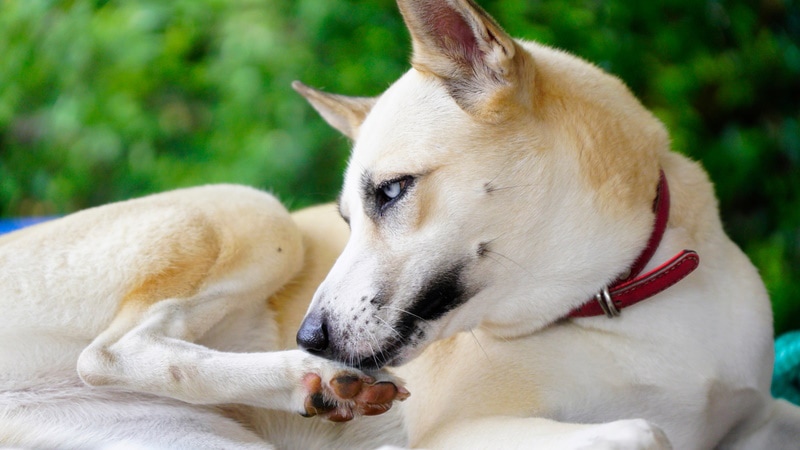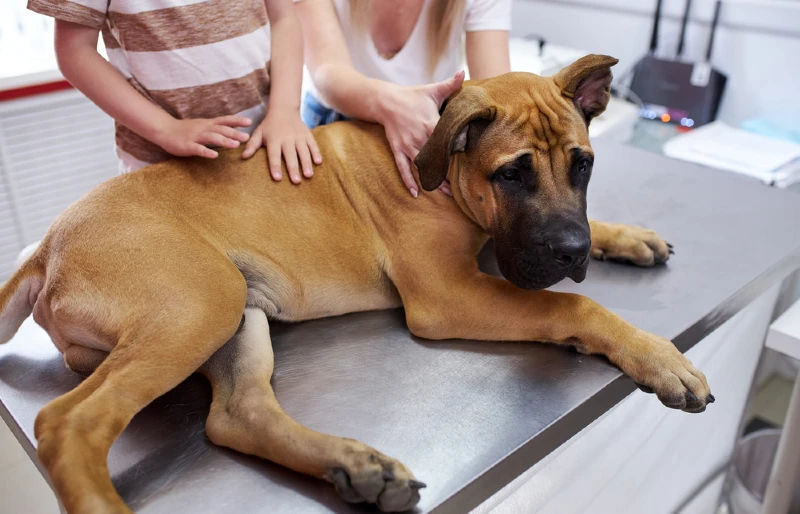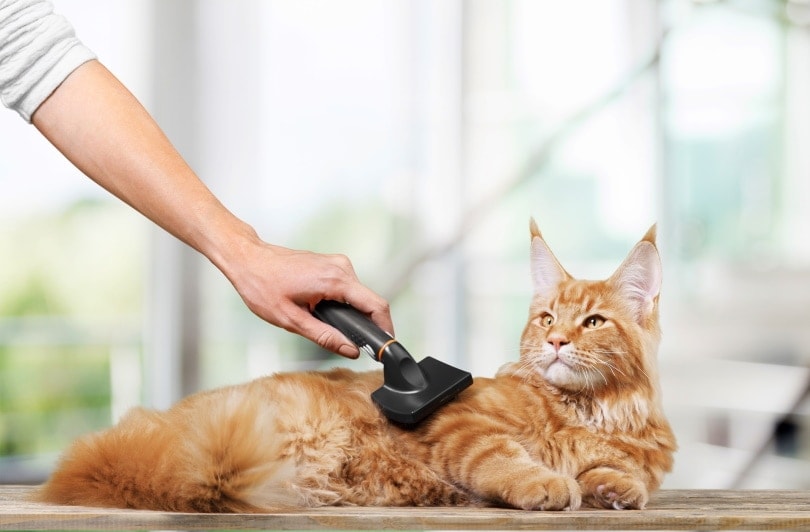Why Are My Dog’s Paws Red? 8 Common Causes & Treatments

Updated on

Click to Skip Ahead
A dog paw is an iconic symbol for a canine pet. It is also easy to overlook our dog’s paws because they are mostly in contact with the ground, but every dog owner should get into a good habit of regularly checking their dog’s paws. A red paw will stand out, and it usually is a red flag, so to speak.
If you have noticed your dog’s paws are red, it could indicate a minor injury that could heal on its own or with a little homecare, but sometimes it could indicate a more serious issue that needs attention. Pododermatitis is the term to describe when your dog’s paws are red and inflamed. The inflammation can be caused by infections (fungal, bacterial, or parasitic), but it can also be caused by genetics, trauma, allergies, immune-mediated problems, cancer, and foreign bodies, among others. Here are some common reasons why your dog’s paws may be red.
Signs of Pododermatitis
If your dog’s paws are red, the inflammation is usually called pododermatitis.
- Red and swollen paws
- Painful paws and itchy paws
- Fluid build-up in the paws
- Small, solid masses
- Lameness
- Thickened, raised, or flat areas
- Discharge from the paws
- Inflammation of the soft tissue around the nail
- Loss of the top portion of the skin
Causes & Treatments of Red Paws in Dogs
1. Yeast Infection
When the conditions are right, a yeast infection can flare up and result in itchy and red paws. Yeast is a spore-producing fungus that is always found on a dog’s skin, usually in small amounts, and when there is an excess of yeast in one place, it might lead to a yeast infection. Although yeast can appear anywhere on the paws, it often occurs on the bottom, between the pads, and occasionally a brown discharge can be seen.
Dog yeast infections tend to be secondary issues. This indicates another problem weakening the skin’s natural defenses and allowing yeast to multiply more rapidly than usual.
Treatment
Topical antifungal creams, wipes, sprays, and shampoos can treat yeast infections on your dog’s skin. To reduce the chance that the condition will return, treating the underlying cause is essential. Regular baths with an antifungal shampoo could be effective, but the foam must stay on a dog’s skin for at least 10 minutes before rinsing. It is always best to consult your veterinarian for a diagnosis and personalized treatment plan if your dog has a yeast infection.

2. Allergies
Allergies are very common in dogs and are usually the most common reason for vet appointments! Your dog’s red paws could be the result of certain allergies. Allergens can make the paws itchy, which can induce licking and biting and make the paws appear red and inflamed. Food, fleas, or seasonal environmental allergens can bring on allergies.
Treatment
The course of treatment will vary depending on what the veterinarian determines your dog is allergic to. The goal of treating allergies is to minimize exposure to the offending substance as much as possible and, if the allergen can’t be avoided, to manage your dog’s itching to help them have the best quality of life possible.
3. Foreign Bodies
If only one of your dog’s paws is red, it could be due to a lodged foreign body such as glass, thorns, splinters, stones, and a common one, grass seeds. It can slowly work its way under the skin and become infected, which will cause inflammation and discomfort.
You may notice your dog limping or repeatedly licking the same paw. The entry hole can be difficult to find as the skin heals over fast, so try to find it as soon as you notice your dog limping or licking.
Treatment
Treatment will depend on the severity of the situation and what may be stuck in your dog’s paw. If it is something small, such as a thorn, you can wash the area with warm soapy water and carefully remove it with tweezers. If the glass is stuck, you should take your dog to the vet as you don’t know how big the piece of the glass is, and your dog may need an x-ray. If the object is embedded, you should not attempt to remove it and get your pal to the vet.
4. Contact Irritants
Red paws may result from your dog stepping on something that irritates its skin. It could be something like roads in the wintertime, cleaning products, or pesticides. If your dog is sensitive to something it may have walked on, it is possible that it will cause inflammation and itching and will result in all four paws being red.
Treatment
First, rinse your dog’s paws to wash off the offending substance and use a protective collar or a sock to prevent licking. If you fear your dog has licked a chemical, take your dog to the vet immediately. Depending on the substance ingested, your vet will develop a treatment plan.

5. Demodectic Mange
Demodectic Mange is a parasitic skin infection that is caused by mites. Demodex mites live at the base of hair follicles. While they are usually not harmful, when an infestation develops in dogs with weak or weakened immune systems, it can cause irritation, redness, and hair loss.
Treatment
Demodectic mange may be contained to a limited body area, making it easier to treat with topical medications. In some circumstances, the infection can affect a dog’s entire body and become a more severe health issue if left untreated.
6. Tick Bites
A tick could be the culprit if the redness in your dog’s paw is more isolated. Ticks often lodge between a dog’s toes, and if they have fed for long enough, they can cause redness in your dog’s paw. The sore left from the tick can cause itching, making your pup lick and bite, contributing to the redness.
Treatment
Ticks carry dangerous diseases, so tick prevention products should be applied to your dog all year round. If the tick has already bitten your dog and caused a red paw, you need to remove the tick and disinfect the area as soon as possible. If in doubt, contact your vet for advice.

7. Burns
When summer temperatures rise, pet parents can easily forget how hot the pavements get. If you took your dog for its usual walk on a sunny, hot day, its paws might have gotten burnt from the hot pavement, and that’s why they may look a bit red. All four paw pads might be affected if that is the case, and your dog may show other signs.
- Red or bleeding paw pads
- Licking
- Limping
- Vocalization
- Hesitant to walk or run
These signs can easily be linked to other issues, but a burn is easy to see. When a dog’s paws have been burned from hot pavement, it can cause fluid-filled blisters that will rupture after a few days. This area will now be exposed and raw and uncomfortable for your dog.
Treatment
Treatment will depend on the severity of the lesion, but if your dog’s paws are visibly red or burnt, your dog should be taken to the vet immediately. The paws will often require bandages, and your vet may prescribe a topical antibiotic because they are prone to infection. You must restrict your dog’s activity and regularly monitor the wounds. Consider purchasing a pair of dog booties to protect your dog’s paws on future walks on hot pavement.
8. Anxiety
A dog may repeatedly lick its paws due to anxiety or boredom which can lead to them becoming red and inflamed. Anxiety can be caused by many factors, such as loud noises, moving, or separation anxiety, and can range from mild to severe. It should never be overlooked. Licking and biting are signs of anxiety, so if your dog is excessively licking its paw, along with other behavioral signs, it could be suffering from anxiety.
- Panting
- Pacing
- Lack of appetite
- Hiding
- Tail chasing
Treatment
In addition to stress management techniques and practices for behavioral changes, your veterinarian may prescribe anti-anxiety medication. Depending on the specific fear trigger for your dog, your veterinarian will either suggest treatments or send you to a veterinary behaviorist who can assist your dog.

Conclusion
Your dog’s paws are essential to their mobility, and their paw health should never be overlooked. Your dog’s paws could appear red for many reasons and become a big problem if not promptly treated. If you are left guessing why your dog’s paws could be red, it is best to get it to a vet as soon as possible, especially if there is no improvement after you treat them at home.
Featured Image Credit: Tienuskin, Shutterstock











